
Mysore, officially Mysuru, is the second-most populous city in the southern Indian state of Karnataka. It is the headquarters of Mysore district and Mysore division. As the traditional seat of the Wadiyar dynasty, the city functioned as the capital of the Kingdom of Mysore for almost six centuries. Known for its heritage structures, palaces, and its culture, Mysore has been called the "City of Palaces", the "Heritage City", and the "Cultural capital of Karnataka". It is one of the cleanest cities in India according to the Swachh Survekshan.

Vijayadashami, more commonly known as Dassahra in Hindi-Urdu, and also known as Dashāhra or Dashain in Bhojpuri, Maithili and Nepali, is a major Hindu festival celebrated every year at the end of Durga Puja and Navarahtri. It is observed on the tenth day of the month of Ashvin, the seventh in the Hindu lunisolar calendar. The festival typically falls in the Gregorian calendar months of September and October, more specifically between 27 September and 26 October. It is celebrated on the tenth day of the waxing moon of the Ashvayuja month.
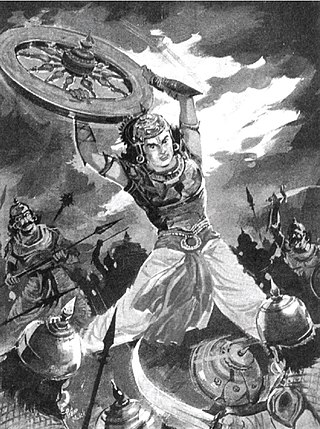
Abhimanyu is a warrior in the Hindu epic Mahābhārata. He was a young and valiant warrior of the Kuru lineage, born to Arjuna—the third Pandava brother—and Subhadra—the sister of the deities Krishna and Balarama. He was also one of the few individuals, along with his father, who knew the technique to enter the Chakravyuha, a powerful military formation. Abhimanyu was raised by his maternal family in Dvārakā because the Pandavas had been exiled for thirteen years by their cousins, the Kauravas. After his father's return, his marriage was arranged with Uttarā, the princess of the Matsya Kingdom.

Droṇa, also referred to as Dronacharya, is a major character of the Hindu epic Mahabharata.

The Chamundi Hill is located 13 km east of Mysore, Karnataka, India. The name comes from the Chamundeshwari Temple at the peak. The average elevation is 1,060 metres (3,480 ft).

Mysore Palace, also known as Amba Vilas Palace, is a historical palace and a royal residence. It is located in Mysore, Karnataka, India. It used to be the official residence of the Wadiyar dynasty and the seat of the Kingdom of Mysore. The palace is in the centre of Mysore, and faces the Chamundi Hills eastward. Mysore is commonly described as the 'City of the Palaces', and there are seven palaces including this one. However, the Mysore Palace refers specifically to the one within the new fort.

The Kurukshetra War, also called the Mahabharata War, is a war described in the Hindu epic poem Mahabharata, arising from a dynastic struggle between two groups of cousins, the Kauravas and the Pandavas, for the throne of Hastinapura. The war is used as the context for the dialogues of the Bhagavad Gita.

Mysore Dasara is the state festival in the state of Karnataka in India. It is a 10-day festival, starting with nine nights called Navaratri and the last day being Vijayadashami. The festival is observed on the tenth day in the Hindu calendar month of Ashvina, which typically falls in the Gregorian months of September and October.
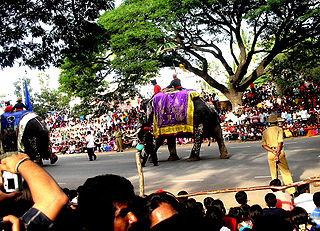
Elephants are an integral part of the Mysore Dasara Festival. The elephants form the core of the Mysore Dasara procession on the Vijayadashami day. The lead elephant carries the Golden Howdah with the Goddess Chamundeshwari in it. The Golden Howdah weighs 750 kilograms and is made of gold.
Balarama was the lead elephant of the Mysore Dasara procession and carried the idol of goddess Chamundeshwari on the fabled Golden Howdah thirteen times between 1999 and 2011. Balarama was a bull born about 1958 and was accompanied in the procession by other Dasara Elephants. Of the many elephants participating, Balarama was one of the star attractions when he carried on his back the sacred idol of goddess Chamundeshwari in the 750 kilograms (1,650 lb) golden howdah on the auspicious 10th day of Dasara celebrations.
Drona was one of the lead Dasara Elephants of the Jamboo Savari of Mysore Dasara. He carried the Golden Howdah for a record 18 years consecutive years between 1981 and 1997, before being electrocuted while grazing in 1998. Of all the carrier elephants since the 20th-century, he is considered the best "because he possessed an excellent ability to learn and correct himself".

The Golden Howdah,'ಚಿನ್ನದ ಅಂಬಾರಿ'(elephant seat or Chinnada Ambari in Kannada) is a howdah, the carrier mounted on the leading elephant during the Jamboo Savari of the famous Mysore Dasara. It is the cynosure of all eyes during the famous Dasara festivities. Since 2020, it has been carried by Abhimanyu.

Mahabharat is an Indian Hindi-language epic television series based on the ancient Sanskrit epic Mahabharata. The original airing consisted of a total of 94 episodes and were broadcast from 2 October 1988 to 24 June 1990 on Doordarshan. It was produced by B. R. Chopra and directed by his son, Ravi Chopra. The music was composed by Raj Kamal. The script was written by Pandit Narendra Sharma and the Hindi/Urdu poet Rahi Masoom Raza, based on the epic by Vyasa. Costumes for the series were provided by Maganlal Dresswala. The serial claims to have used the Critical Edition of Bhandarkar Oriental Research Institute as its basic source with Vishnu Sitaram Sukthankar and Shripad Krishna Belwalkar as its primary editor.
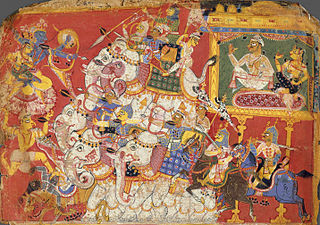
Bhagadatta was the son of Narakasura and grandson of Lord Shree Adivaraha, and the king of Pragjyotisha in Hindu mythology. Bhagadatta was born from a limb of the asura called Bashkala. He was a renowned warrior, and was known to be a great friend of Indra. When Arjuna embarked on a conquest to help his brother Yudhishthira perform the rajasuya yajna, Bhagadatta was one of the first kings to be conquered by him.
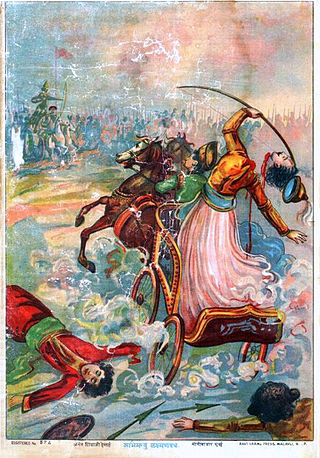
In the Hindu epic Mahabharata, Lakshmana Kumara, also rendered Lakshmana is the son of king Duryodhana and queen Bhanumati and a grandson of Dhritarashtra and Gandhari. He is described to have a twin sister called Lakshmanā, who is kidnapped by Samba, a son of Krishna. He is slain on the thirteenth day of the Kurukshetra War by Abhimanyu, who decapitates him using an arrow.
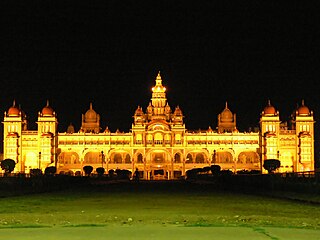
The Mysore Dasara 2013 is the 403rd edition of the annual royal festive gala event, a show of pomp and tradition that is held in the Mysore city in Karnataka, India for 10 days. The festival is called the Navaratri (meaning nine nights or Dussehra or Vijayadashami which conforms to the bright half of the month of Ashvin, from pratipadathithi to navamithithi in the Hindu calendar corresponding to 5 to 13 October during 2013. The festival is also called Nada Habba in Kannada language. The first day of the nine-day festivity started on 5 October with the traditional and religious special puja performed to Goddess Chamundeshwari in the Chamundi Temple on top of the Chamundi Hill, which forms the backdrop to the city; the temple was beautifully decorated with flowers and tourist from Gujarat, Rajasthan and other states enthralled the audience with their bhajan singing. On this occasion, floral tribute wa offered to the goddess by Jnanpith Award winner Chandrashekhara Kambara and festivities will continue for ten days. The ninth day of the festival is a special event called the Mahanavami when the royal sword is worshipped and taken in a procession of elephants, camels and horses. The festival concludes on 14 October on the dashami day with the grand finale of Jambusavari with the idol of Chamundeshawri set in a golden howdah mounted on a richly caparisoned elephant. The procession is taken through the streets of the city and ends in the Banni Mantap where, in the evening, a torch light parade is held. Symbolically, the festival represents the victory of good over evil.
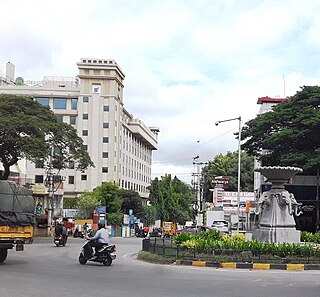
Bannimantap is an historical place in the Indian city of Mysore, Karnataka, India. where the world famous Mysore Dasara Jumbo Savari parade marks the end and after which cultural programmes are host every year on Vijayadashami in the presence of the Governor of Karnataka, Chief Minister of Karnataka and other Council of Ministers of the Govt. of Karnataka.

Hanumanthanagar is a locality in Bannimantap, a suburb of Mysore coming on the Northern side of the city. It is part of Mysore district in Karnataka state of India. Hanumanth Nagar is famous for the Jumbo Savari with the golden Howdah, a part of Mysore Dasara, which marks an end of the procession in Bannimantap via Highway Circle of Hanumanth Nagar.
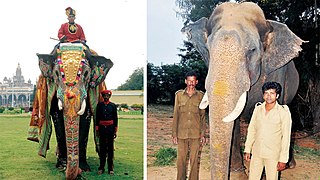
Abhimanyu is an Asian elephant who, from 2020 has been the lead elephant and the carrier of the Golden Howdah at the Mysore Dasara and is also stated to be the best kumki elephant, playing a crucial role in more than 180 elephant captures and more than 50 tiger captures.
















